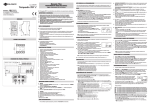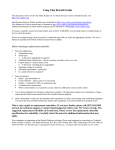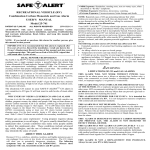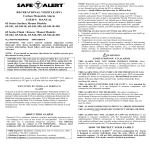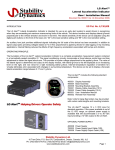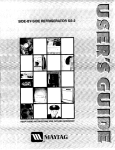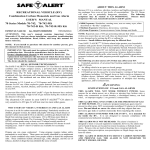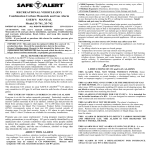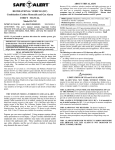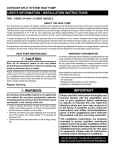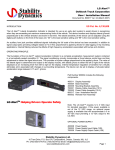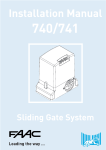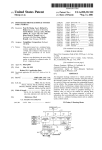Download (CO) ALARM USER`S MANUAL
Transcript
RESIDENTIAL & UNCONDITIONED Areas CARBON MONOXIDE (CO) ALARM USER’S MANUAL • An idling vehicle in an open or closed garage, or near a home can cause high levels of CO to build up in a residence. • Temperature inversions can trap exhaust near the ground • CO build up can be caused by reverse/negative venting of fuel burning appliances including; 1) Clogged, loose or faulty stacks or chimneys of (clothes dryers, furnaces and water heaters, etc.), 2) wind direction and/or velocity, 3) simultaneous operation of multiple fuel burning appliances, and/or exhaust fans. 60-511 120 vAC Line Cord 60-531 120 vAC Hard Wire 60-521 120 vAC Plug In PATENTS PENDING ALL RIGHTS RESERVED 60C0-1096-11 ATTENTION: This user’s manual contains important Carbon Monoxide (CO) alarm installation, operation, troubleshooting and warranty information. Read, follow, and keep this manual for future reference. NOTE: If you install or purchase this alarm for another person, give this manual to that person. IMPORTANT: This unit must be replaced within 5 years of its production date. See Owner’s replacement Record in this manual. The replacement date indicates the date beyond which the device may no longer detect carbon monoxide accurately. WHY EVERY HOME / BUSINESS NEEDS A CO ALARM Everyone is at risk for carbon monoxide poisoning! Particularly sensitive are children, pregnant women, the elderly and people with lung or heart disease or anemia! Carbon monoxide (CO) is an odorless, colorless gas that prevents the blood from carrying oxygen to vital organs. CO is 200 times more likely to replace oxygen in the blood. ABOUT CO GAS AND YOUR NEW CO ALARM Because CO is a colorless, odorless, tasteless and highly poisonous gas; it can endanger lives even at low levels of concentration. Your CO alarm will alert you to potentially dangerous situations. The electronic sensor in your SAFE-T-ALERT TM CO alarm is selfcleaning and very sensitive to CO gas. It will not react to nonhazardous levels of most other gas. The following symptoms may be related to CO POISONING and should be discussed with ALL members of your household: • • Mild MildExposure: Exposure:Headaches, Headaches,running runningnose, nose,sore soreeyes, eyes,often often described “flu-like”symptoms. symptoms. described asas “Flu-like” •Medium MediumExposure: Exposure: Dizziness,drowsiness, drowsiness,vomiting. vomiting. Dizziness, Extreme Exposure: Unconsciousness, brain damage, • Extreme Exposure: Unconsciousness, brain damage,death. death. • NOTE: Many cases Many of cases reported of reported CO poisoning CO poisoning indicateindicate that while thatvictims while victims are aware they arewell, not well, become disoriented. they They are are are aware they are not theythey become so disoriented unable byby either exiting the the building or calling for unabletotosave savethemselves themselves either exiting building or calling assistance. Young children and pets be affected first. first for assistance. Also, children and may pets may be affected SAFE-T-ALERTTM model’s 60-511, 60-521, and 60-531 are UL® listed to UL standard 2034 (Rev. November 14, 2003) for use in residential and unconditioned areas. (Units located in garages or commercial kitchens may experience more alarms than units located in other areas.) The Consumer Product Safety Commission (CPSC) recommends use of at least one carbon monoxide alarm per household, located outside of sleeping areas. For maximum security, locate an alarm in each bedroom, near combustion sources, and on every level of the house. Your SAFE-T-ALERT TM CO alarm helps protect your household members and guests from CO. CO gas is produced when any type of fuel is incompletely burned. The following are also sources of CO that may affect your home : • Extended operation of unvented fuel burning appliances can build up high CO levels. NOTE: The TEST/RESET button on the SAFE-T-ALERT TM CO alarm accurately tests all alarm functions. It is the only way to test the alarm. ! WARNING: LIMITATIONS OF CARBON MONOXIDE ALARMS CO ALARMS WILL NOT WORK WITHOUT POWER. Some examples causing no alarm power are a blown or missing fuse, broken wire, a faulty wire connection or circuit breaker, or a discharged battery. CAUTION-THIS ALARM WILL ONLY INDICATE THE PRESENCE OF CO GAS AT THE SENSOR. CO gas may be present in other areas. MTI recommends that alarms be installed in all sleeping areas. CO ALARMS MAY NOT BE HEARD. The alarm’s loudness is designed to meet or exceed regulatory standards, however, the alarm may not be heard if alarms are located in remote locations or behind closed doors. Persons who are hard-of-hearing, have consumed alcoholic beverages, taken prescription, non-prescription or illegal drugs, may not hear the alarm. THIS CO ALARM IS DESIGNED TO DETECT CARBON MONOXIDE FROM ANY SOURCE OF COMBUSTION. IT IS NOT DESIGNED TO DETECT SMOKE, FIRE, OR ANY OTHER GAS. This device may not alarm at low CO levels. This CO alarm is intended for use in ordinary indoor locations of family living units. It is not designed to measure compliance with the Occupational Safety Health Administration (OSHA) commercial or industrial standards. Individuals with medical problems may consider using warning devices, which provide audible and visual signals for CO concentrations under 30 ppm. See the section, Visual and Audible Alarm Signals, in this manual for further information. ! WARNING THIS PRODUCT IS INTENDED FOR USE IN ORDINARY INDOOR RESIDENTIAL, RV AND BOAT AREAS. IT IS NOT DESIGNED TO MEASURE COMPLIANCE WITH COMMERCIAL AND INDUSTRIAL STANDARDS. HOW TO PROTECT YOUR FAMILY FROM CO GAS CAUTION-The SAFE-T-ALERTTM CO alarm is designed to protect individuals from acute effects of carbon monoxide exposure. It will not fully safeguard individuals with specific medical conditions. If in doubt, consult a medical practitioner. To protect your family, you should: • INSTALL CO ALARMS PROPERLY. Carefully read and follow ALL the instructions in this manual. Test your unit every week. Alarms that do not work will not alert you to hazardous levels of CO gas. See the section, Test Procedure, in this manual for further information. • MAKE REGULAR VISUAL INSPECTIONS. Check all fuel burning equipment including gas water-heaters, kitchen gas stoves, space heaters, gas dryers and all pilot lights. Check the color of the pilot flame. The color should be blue. • HAVE CHIMNEYS AND FLUES CLEANED YEARLY. A poor draft in a fireplace can prevent proper air movement and lead to CO buildup in the home. • MAINTAIN ALL GAS AND OIL BURNING EQUIPMENT PROFESSIONALLY. Gas, oil and private companies offer professional inspections of appliances for a nominal fee. INSTALLATION INSTRUCTIONS Models 60-511, 60-521 and 60-531 ! WARNING FAILURE TO FOLLOW THE FOLLOWING INSTRUCTIONS MAY RESULT IN A MALFUNCTION OF THE ALARM AND MAY VOID THE WARRANTY. WHERE TO INSTALL CO ALARMS For MINIMUM protection, install CO alarms near all sleeping areas and on each level of the home See Figures 1 & 2. All SAFE-TALERT TM residential models comply with UL 2034 rev. November 14, 2003 and may be installed in heated or unconditioned areas (garage, furnace or boiler room, basement, utility room, cabin, cottage, etc.) For MAXIMUM protection, CO alarms should be installed in each bedroom and sleeping area, and on each level of the residence, including the basement. BEDROOM BEDROOM BEDROOM KITCHEN DINING ROOM LIVING ROOM FIGURE 1 GARAGE CO DETECTOR LOCATION FOR MINIMUM SECURITY CO DETECTOR LOCATION FOR GREATER SECURITY ! WARNING CONNECT ONLY TO WIRING THAT CANNOT BE TURNED OFF BY A SWITCH OR GROUND FAULT PROTECTOR. ONLY USE UL® OR RECOGNIZED CONNECTORS. ALL CONNECTIONS MUST BE IN ACCORDANCE WITH THE NATIONAL ELECTRICAL CODE OR CANADIAN ELECTRIC CODE. ! WARNING THESE ALARMS ARE DESIGNED TO BE MOUNTED ON A WALL OR CEILING 6” (15CM) FROM THE WALL/CEILING LINE. SEE WHERE TO AND NOT TO INSTALL CO ALARMS . Follow the instructions for the unit you are installing. 60-511 120 vAC Line Cord 1. Choose a wall location at least 6 inches below the ceiling for your CO alarm. Make sure it is within easy reach for testing. The alarm mounting location should be within five feet of an electrical outlet. The power cord must be routed close to the wall. Make sure a switch or ground fault interrupter CANNOT turn off the electrical circuit to the outlet. 2. Fasten the alarm to the wall using the two screw holes. Route the cord so it is not too tight. Plug in the transformer to the 120 vAC outlet and secure with a bracket. A raceway is recommended to protect the line cord . ! BEDROOM WARNING SHOCK HAZARD: TURN OFF POWER BEFORE INSTALLING. BEDROOM GARAGE LIVING ROOM BEDROOM KITCHEN BASEMENT FIGURE 2 MULTI-LEVEL HOME FURNACE CO DETECTOR LOCATION FOR MINIMUM SECURITY CO DETECTOR LOCATION FOR RECOMMENDED SECURITY WHERE NOT TO INSTALL CO ALARMS • DO NOT INSTALL ALARMS behind furniture, drapes, in closets or areas that will block air flow to the alarm. • DO NOT INSTALL ALARMS within 12 inches (30cm) of opening windows, exterior doors, heating or return vents, or other drafty areas or 6” (15cm) of the wall/ceiling line. • DO NOT INSTALL ALARMS within 5 feet (1.5m) of any cooking appliance. NOTE: Older homes and manufactured homes may not be as air tight as newer homes. Use caution when selecting an installation on outside walls and near windows . 60-521 120 vAC Direct Plug-In 1. Remove the wall plate screw. Plug in the alarm and fasten it to the wall plate using the wall plate screw. 2. Turn on the breaker. 60-531 120 vAC Hard Wire 1. Install the cover plate onto a 2” x 4” electrical box. Wire nuts are not provided. 2. Connect wire leads—white-to-white and black-to-black. 3. Fasten the alarm to the wall plate. 4. Turn on the breaker. TEST PROCEDURE ! WARNING TO REDUCE THE RISK OF CARBON MONOXIDE POISONING, TEST THE ALARM’S OPERATION AT LEAST ONCE PER WEEK. ! WARNING DO NOT attempt to test the alarm by any other means than by using the TEST/RESET button. DO NOT attempt to produce CO to test the alarm. The TEST/RESET button tests all functions of the alarm and is the ONLY safe way to be sure the alarm is working properly . The alarm may be tested at any time after power is applied by pressing the TEST/RESET button, located on the front of the alarm. The alarm is working properly if the GREEN indicator light changes color to RED and the horn sounds. OPERATION TM Each SAFE-T-ALERT CO alarm is equipped with a self-cleaning CO sensor and requires a ten (10) minute initial warm-up period to clean the sensor element and achieve stabilization. The GREEN indicator will flash on and off during the 10 minute warm up period. The GREEN power ON indicator should glow continuously after the warm up period. If the ON indicator light does not light, see the section, Trouble-Shooting Guide, in this manual for further information. Do not attempt to fix it yourself. TROUBLE-SHOOTING GUIDE Use this chart to trouble-shoot problems with your CO alarm. PROBLEM CAUSE/SOLUTION GREEN LIGHT OFF 1.Wire Connection 2. Reversed Wiring 3. Main Power Off 4. Contact Customer Service NO SOUND IN TEST NO RED LED IN TEST LOCKED IN RED ALARM Contact Customer Service Contact Customer Service Contact Customer Service VISUAL AND AUDIBLE ALARM SIGNALS This SAFE-T-ALERT TM CO alarm is designed to be easy-tooperate. The alarm has an indicator light that displays a specific color for each monitored condition. There also is a matching sound pattern for alarm conditions. 1. LOW CO ALARM – is indicated by a FLASHING RED LIGHT AND 4 AUDIBLE “BEEPS” THEN OFF FOR 5 SECONDS. These signals indicate the presence of 70 ppm or more of CO. IMMEDIATE ACTION IS REQUIRED. See the section, Procedures To Take During An Alarm, in this manual for further information. This cycle will continue until the TEST/RESET button on the front of your unit is pressed. The TEST/RESET button temporarily silences the CO alarm. Ventilate the area. The RED light will continue to flash until the CO has cleared, or the alarm will reactivate in approximately 6 minutes in the event CO is still present. If the level of CO continued to rise above 100 ppm, the FLASHING RED LED will change to STEADY RED. 2. HIGH CO ALARM - is indicated by a STEADY RED LIGHT AND 4 AUDIBLE “BEEPS” THEN OFF FOR 5 SECONDS. These signals indicates that the CO level is over 100 ppm. IMMEDIATE ACTION IS REQUIRED. . See the section, Procedures To Take During An Alarm, in this manual for further information. This cycle will continue until the TEST/RESET button on the front of your unit is pressed. Ventilate the area. The RED light will stay ON until the CO has cleared, or the alarm will reactivate in approximately 6 minutes if the CO is still present. 3. MALFUNCTION/SERVICE SIGNAL – is indicated by ALTERNATING RED AND GREEN LIGHTS AND ONE AUDIBLE BEEP EVERY 30 SECONDS. If this signal sounds, press the TEST/RESET button. If the TEST/RESET button does not clear the signals, return for service. See the section, Warranty Return Procedures. SPECIAL MEMORY FEATURE – This SAFE-T-ALERTTM CO alarm has a Peak Level Memory feature that remembers the approximate amount of CO that activated the alarm. To activate alarm level memory, press the TEST/RESET button for less than 1 second. You can repeat this feature at any time. (1) “BEEP” and 1 GREEN FLASH indicate the memory is clear. (2) “BEEPS” and 2 RED FLASHES indicate less than 100 ppm. (3) “BEEPS” and 3 RED FLASHES indicate less than 200 ppm. (4) “BEEPS” and 4 RED FLASHES indicate over 200 ppm. You can only erase memory by disconnecting power for 15 seconds . ALARM WITH RED/GREEN 1. Check Battery Voltage LED AND WILL NOT RESET 2. Contact Customer Service HOW TO TAKE CARE OF YOUR ALARM Your CO alarm is designed to be as maintenance free as possible. To keep your alarm in good working order, you must: • TEST THE ALARM WEEKLY. See the section, Test Procedure, in this manual for further information. • VACUUM THE DUST OFF THE ALARM COVER. At least once a year (more frequently in dusty locations), use the soft brush attachment of your vacuum to clean the alarm cover. • CLEAN THE ALARM COVER WHEN DIRTY. Wash the alarm cover by hand. Use a cloth dampened in clean water. Dry with a soft cloth. • DO NOT SPRAY CLEANING AGENTS OR WAXES DIRECTLY ONTO THE FRONT PANEL. The alarm area should be well ventilated when household cleaning supplies or similar contaminants are used. • OBSERVE THE COLOR OF THE INDICATOR LIGHT. At frequent intervals and during your weekly test, check the indicator light on the on the front panel of the alarm. See the section, Operation, in this manual for further information. PROCEDURES TO TAKE DURING AN ALARM Follow the alarm procedures for your country. The emergency number depends on your travel location. PROCEDURES TO TAKE DURING AN ALARM IN CANADA ! WARNING: Actuation of this device indicates the presence of carbon monoxide (CO) which can KILL YOU. If signal sounds (4 beeps and flashing or solid red light: 1) Immediately move to fresh air - outdoors or by an open door/window. Check that all persons are accounted for. Do not reenter the premises or move away from the open door/window until the emergency responders have arrived, the premises have been aired out, and your alarm remains in its normal condition; 2) call your emergency local service (telephone number _________) ( fire department or 911). PROCEDURES TO TAKE DURING AN ALARM IN THE USA ! WARNING: Actuation of this device indicates the presence of carbon monoxide (CO), which can KILL YOU. If signal sounds (4 beeps and flashing or solid red light): 1) Operate the reset/silence button; 2) Call your emergency local service (Phone Number _____________ ) (fire department or 911); 3) Immediately move to fresh air outdoors or by an open door/window. Check that all persons are accounted for. Do not reenter the premises or move away from the open door / window until the emergency responders have arrived, the premises have been aired out and your alarm remains in its normal operation. 4) After following steps 1-3, if your alarm reactivates within a 24-hour period, repeat steps 1-3 and call a qualified appliance technician. (Phone Number _______________) to investigate for sources of CO from fuel burning equipment and appliances, and inspect for proper operation of this equipment. If problems are identified during this inspection have the equipment serviced immediately. Note any combustion equipment not inspected by the technician and consult the manufacturers’ instructions, or contact the manufacturer directly, for more information about CO safety and this equipment. Make sure that the motor vehicles are not, and have not been, operating in an attached garage or adjacent to the residence. LIMITED PRODUCTS WARRANTY MTI INDUSTRIES, INC. warrants to the original retail purchaser that its products will be free from defects of material or workmanship for a period of FIVE (5) years from the date of retail purchase. If proven to have been defective in original materials or workmanship and returned, delivery costs prepaid, MTI INDUSTRIES, INC. will replace this product free of charge. LIMITS OF WARRANTY Replacement is your exclusive remedy under this limited warranty or any other warranty (including any implied warranty of merchantability for a particular purpose). Any and all implied warranties or merchantability or fitness for a particular purpose shall be limited to the warranty period from the original date of retail purchase. MTI INDUSTRIES, INC., its dealers and distributors shall in no case be responsible or in any way liable for any incidental or consequential damages for any reason. Some states do not allow the limitation or exclusion of incidental or consequential damages, or allow limitations on how long an implied warranty lasts, so the above limitations may not apply to you. This warranty gives you specific rights, and you may also have other rights, which may vary, from state to state. PRODUCT NOT WARRANTED NOTE- There are no user serviceable parts inside the case. Opening any SAFE-T-ALERT TM product for any reason voids the warranty. This warranty does not cover damage or failure resulting from acts of God, abuse, misuse, neglect, or faulty installation. WARRANTY RETURN PROCEDURES It is MTI’s experience that a Carbon Monoxide alarm is sounding for a reason. Contact our Customer Service Department to trouble-shoot the situation. Customer Service Phone No. - 800-383-0269 Fax No. 847-546-9007 E-mail [email protected] Web Site: www.mtiindustries.com If Customer Service determines that the unit is defective, a Replacement Authorization (RA) number will be issued. No product will be accepted for service or replacement without first obtaining a RA number. If authorized, return this product to: MTI Industries, Inc. Warranty Dept. RA # (INSERT RA NUMBER HERE) 31632 N. Ellis Drive Unit 301 Volo, IL 60073 NOTE: Mark the RA number in the area shown on the outside of the box. SPECIFICATIONS SAFE-T-ALERT™ Models 60-511 60-521 60-531 Power Supply 120 vAC Operating Voltage Frequency 102- 132 VAC 60 HZ Average Standby Current Draw 60-511 3.5 Watts 60-521 2.2 Watts 60-531 2.2 Watts Operational Temperature -40o F to +150o F Relative Humidity 15% (+/- 5%) to 95% (+/- 4%) Gas Detected Carbon Monoxide CO Alarm Level Low CO Alarm No Alarm Warm Up Time Alarm Silence Time OVER 100 PPM 70 to 100 PPM 30 ppm for 30 Days 10 Minutes Under 6 Minutes Case Dimensions Audible Alarm 60-511 5” x 3” x1.5” 60-531 6.5” x 3.5” x 1.5” 60-521 5” x 3” x 1.5” 85 dB @ 10 Feet OPERATION AUDIBLE SIGNAL NORMAL NONE LOW CO ALARM -40o C to +66o C VISUAL SIGNAL STEADY GREEN 4 “BEEPS” 5 SECONDS OFF FLASHING RED CO ALARM 4 “BEEPS” 5 SECONDS OFF STEADY RED ALARM MALFUNCTION “BEEP” EVERY 30 SECONDS 5 UL® 2034 Rev. November 14, 2003 Ulc-CSA 6,19-01 ALTERNATING RED/GREEN Single Station Residential and Unconditioned Areas OWNERS REPLACEMENT RECORD Replace this SAFE-T-ALERT TM propane alarm within 5 years, of the of the production date on the back of the alarm. Production Date ______________________ Replace Date ______________________ Installer ________________________ NOTE: The replacement date indicates the date beyond which the device may no longer detect accurately. The alarm should be replaced immediately. © MTI INDUSTRIES 2004







